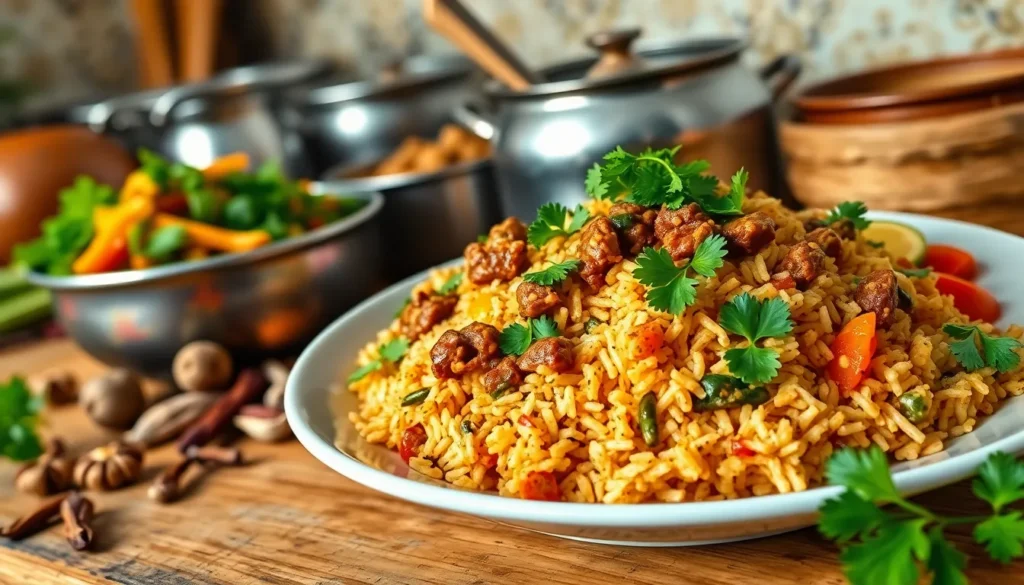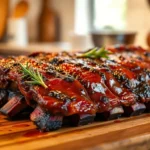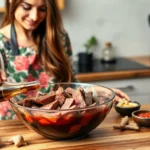We’re taking you on a flavorful journey to the heart of Kenyan cuisine with our authentic beef pilau rice recipe. This aromatic one-pot wonder combines tender beef chunks with perfectly spiced basmati rice that’s been a cornerstone of Kenyan households for generations. The dish traces its roots to the coastal regions where Swahili culture meets Indian Ocean influences.
What makes Kenyan pilau truly special is its distinctive blend of whole spices – cardamom, cinnamon, cloves, and cumin – that infuse every grain of rice with incredible depth. We’ll show you how to achieve that signature golden color and rich taste that makes this dish irresistible.
Our step-by-step method ensures your beef becomes melt-in-your-mouth tender while the rice absorbs all those beautiful flavors. Whether you’re cooking for family dinner or entertaining guests, this beef pilau delivers restaurant-quality results right from your kitchen.
Ingredients
We’ve carefully selected each ingredient to create the perfect balance of flavors that define authentic Kenyan beef pilau. Our ingredient list ensures you achieve the aromatic depth and tender texture that makes this dish so beloved.
For the Beef
- 2 pounds beef chuck roast or stewing beef, cut into 2-inch cubes
- 2 tablespoons vegetable oil
- 1 large onion, thinly sliced
- 4 cloves garlic, minced
- 1 tablespoon fresh ginger, grated
- 2 medium tomatoes, chopped
- 1 teaspoon salt
- 1/2 teaspoon black pepper
- 2 beef bouillon cubes
- 3 cups warm water
For the Rice
- 2 cups basmati rice, rinsed until water runs clear
- 1 large onion, thinly sliced
- 3 tablespoons vegetable oil
- 1 teaspoon salt
- 4 cups beef stock (from cooking the beef)
- 1/4 cup raisins (optional)
- 2 tablespoons fresh cilantro, chopped
Spices and Aromatics
- 6 green cardamom pods, lightly crushed
- 4 whole cloves
- 2 cinnamon sticks
- 1 teaspoon whole cumin seeds
- 1 bay leaf
- 1 teaspoon turmeric powder
- 1 teaspoon curry powder
- 1/2 teaspoon ground coriander
- 1/4 teaspoon ground nutmeg
- 2 tablespoons tomato paste
Equipment Needed
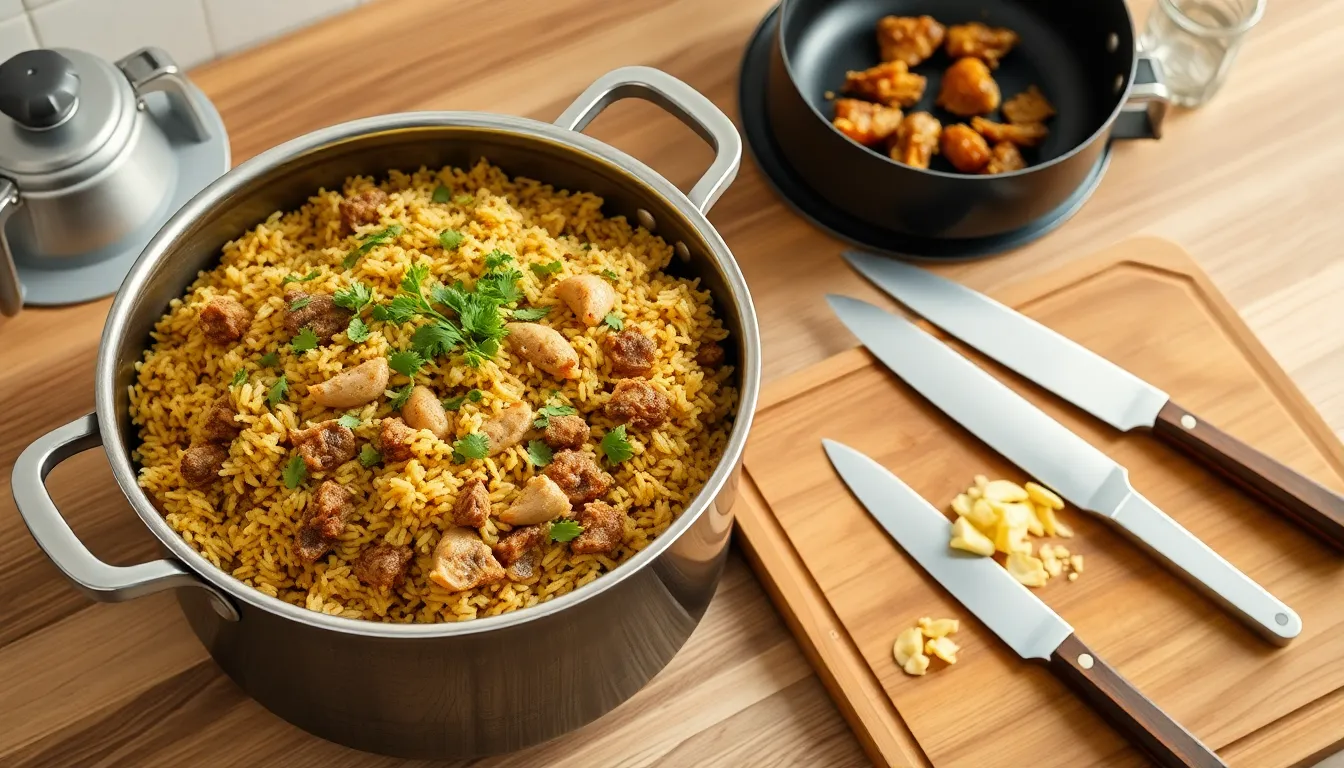
Creating authentic Kenyan beef pilau requires exact cookware that ensures even cooking and proper flavor development. We’ve selected essential equipment that will help you achieve restaurant-quality results in your home kitchen.
Large Cooking Pot or Deep Pan with Lid serves as our primary vessel for this recipe. The pot should accommodate at least 4-5 quarts to allow proper beef cooking and rice expansion. A heavy-bottomed design distributes heat evenly and prevents burning during the long simmering process.
Frying Pan or Skillet becomes invaluable for caramelizing onions to perfection. We recommend a medium-sized pan that provides enough surface area for browning without overcrowding. This separate cooking step intensifies the onion flavors that form the foundation of our pilau.
Sharp Knife and Cutting Board help precise ingredient preparation. A chef’s knife works best for cubing beef into uniform pieces and chopping aromatics like onions, garlic, and ginger. Consistent sizing ensures even cooking throughout the dish.
Measuring Spoons and Cups guarantee accurate spice proportions and liquid ratios. Proper measurements maintain the delicate balance of flavors that makes Kenyan pilau distinctive. We use both dry and liquid measuring tools for precision.
Wooden Spoon or Heat-Resistant Spatula provides gentle stirring without damaging the rice grains. These tools won’t scratch your cookware and allow for easy maneuvering of ingredients during the cooking process.
Medium Mixing Bowl assists with rice washing and preparation. Rinsing basmati rice until the water runs clear removes excess starch and prevents clumpy results. A bowl with adequate capacity makes this step more efficient.
Reliable Heat Source maintains consistent temperature control throughout cooking. Whether using gas or electric, steady heat regulation prevents scorching and ensures proper absorption of the aromatic beef stock.
Instructions

Now that we have our ingredients and equipment ready, let’s transform them into an authentic Kenyan beef pilau that captures the essence of coastal East African cuisine. Each step builds upon the previous one to create layers of flavor that make this dish truly exceptional.
Prep the Beef
We begin by cutting our 2 pounds of beef chuck roast into uniform cubes, approximately 1-inch pieces for even cooking. Season the beef generously with salt and freshly ground black pepper, ensuring each piece is well coated. Create a paste by mincing fresh garlic and ginger together, or use a mortar and pestle for the most authentic texture. Rub this aromatic paste into the beef cubes, allowing the flavors to penetrate the meat. Let the seasoned beef rest at room temperature for 15 minutes while we prepare our spice blend.
Prepare the Spice Mix
Heat a dry pan over low heat and add our whole spices: cumin seeds, black peppercorns, cinnamon sticks, cardamom pods, and cloves. Toast them gently for 2-3 minutes until they release their fragrant oils and become aromatic. Remove the spices from heat immediately to prevent burning and allow them to cool completely. Transfer the cooled spices to a spice grinder or clean coffee grinder and pulse until we achieve a fine powder. This fresh pilau masala will provide the distinctive flavor profile that sets authentic Kenyan pilau apart from other rice dishes.
Cook the Beef
Pour 1/4 cup of vegetable oil into our large cooking pot and heat over medium-high heat until shimmering. Add the thinly sliced onions and fry them patiently for 10-15 minutes, stirring occasionally until they turn golden brown and caramelized. Add our garlic-ginger paste and minced serrano pepper, sautéing for 1-2 minutes until the mixture becomes fragrant. Introduce the seasoned beef cubes to the pot along with 1.5 tablespoons of our freshly ground pilau masala, bay leaves, and beef stock cubes. Cook the beef for 8-10 minutes, stirring occasionally to ensure even browning and caramelization on all sides. Add the diced tomatoes and continue cooking for 4-5 minutes until they break down and release their juices, creating a rich base for our pilau.
Prepare the Rice
Measure 2 cups of basmati rice into a medium bowl and rinse it thoroughly under cold running water until the water runs clear, removing excess starch that could make our pilau sticky. Drain the rice completely and set it aside. This washing process ensures each grain will remain separate and fluffy in the finished dish. Meanwhile, bring 3 cups of beef broth or water to a gentle simmer in a separate pot, keeping it warm for when we add the rice to our beef mixture.
Assemble the Pilau
After the beef has simmered with the tomatoes for about 10 minutes, add the quartered potatoes if using them for extra heartiness. Pour the warm broth gradually into the pot, stirring gently to combine all ingredients. Bring the mixture to a rolling boil, then carefully add our washed rice, distributing it evenly throughout the pot. Stir the rice gently into the beef and spice mixture, ensuring every grain is coated with the aromatic cooking liquid. Taste and adjust seasoning with salt as needed, remembering that the flavors will concentrate as the liquid reduces.
Final Cooking
Cover the pot tightly with a lid or aluminum foil to create a perfect seal that traps steam and prevents moisture loss. Reduce the heat to low and allow the pilau to simmer undisturbed for 20 minutes. Resist the temptation to lift the lid during this time, as releasing steam will affect the cooking process. After 20 minutes, remove the pot from heat and let it rest for 5 minutes before uncovering. Fluff the rice gently with a fork, mixing the aromatic spices and tender beef throughout the grain. Remove the bay leaves and serve immediately while hot, accompanied by fresh kachumbari for a refreshing contrast to the rich, spiced pilau.
Directions for Serving
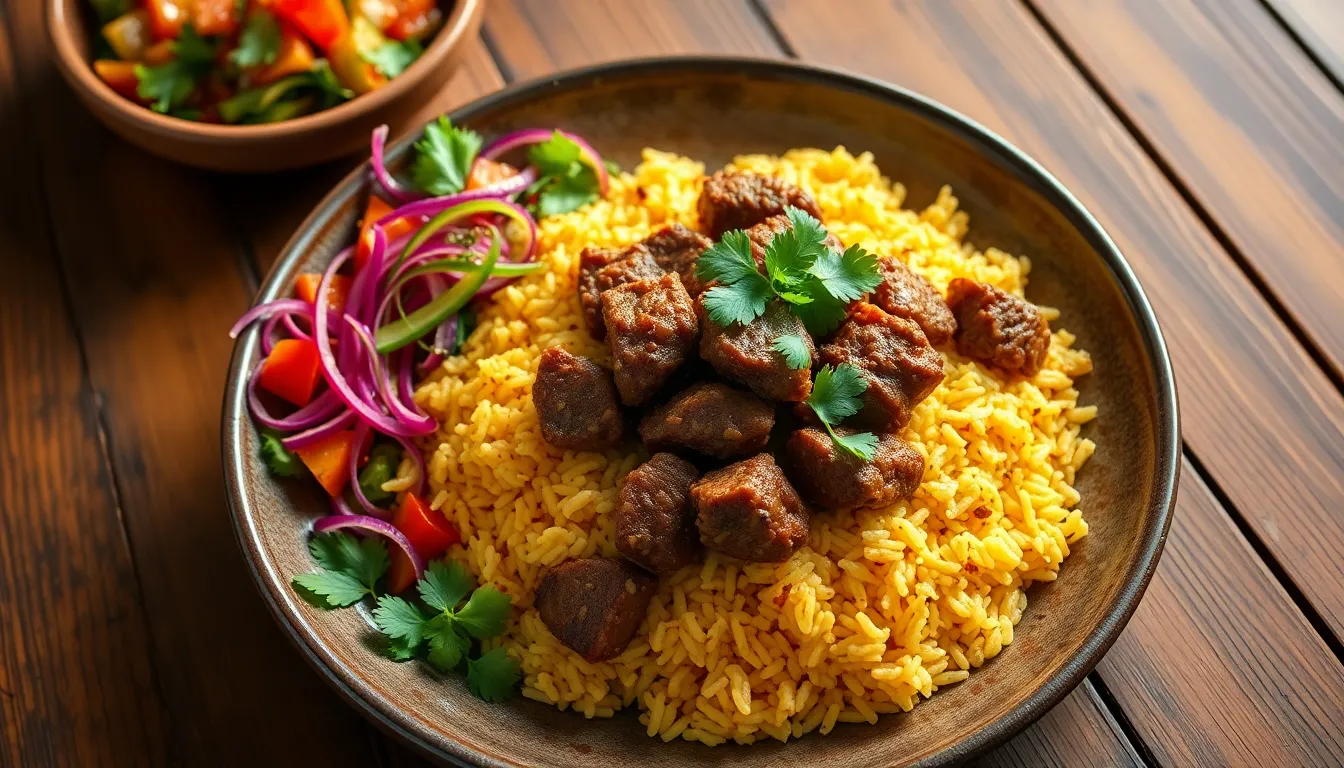
We serve our Kenyan beef pilau rice hot as the centerpiece of the meal. This aromatic dish works beautifully as a standalone main course that satisfies appetites and delivers authentic East African flavors to your table.
Fresh kachumbari provides the perfect accompaniment to our beef pilau. We prepare this traditional tomato and onion salad to add a refreshing contrast that cuts through the rich spices and tender beef. The crisp vegetables balance the warm aromatics beautifully.
Family gatherings become memorable occasions when we present this festive dish. Our beef pilau transforms ordinary dinners into special celebrations that bring everyone together around the table. The golden rice and fragrant spices create an inviting atmosphere that makes every meal feel like an event.
Party planning becomes effortless with this crowd-pleasing recipe. We often prepare larger batches for entertaining because the dish holds well and actually improves in flavor as it rests. Guests consistently request the recipe after experiencing the authentic taste of our Kenyan beef pilau.
Traditional Kenyan meals expand when we serve additional sides alongside our pilau. Meat stews complement the rice dish perfectly while vegetable sides add variety and nutrition to the spread. These combinations create a complete East African dining experience.
Garnishing with fresh cilantro adds the final touch that elevates presentation. We sprinkle the bright green herbs generously over the steaming pilau just before serving. The fresh cilantro provides a pop of color and herbaceous note that enhances the overall flavor profile.
Storage considerations matter when we prepare this dish ahead of time. Our beef pilau reheats beautifully and maintains its texture when stored properly in the refrigerator. We often make extra portions knowing that leftovers taste even better the next day as flavors continue to meld together.
Make-Ahead Tips
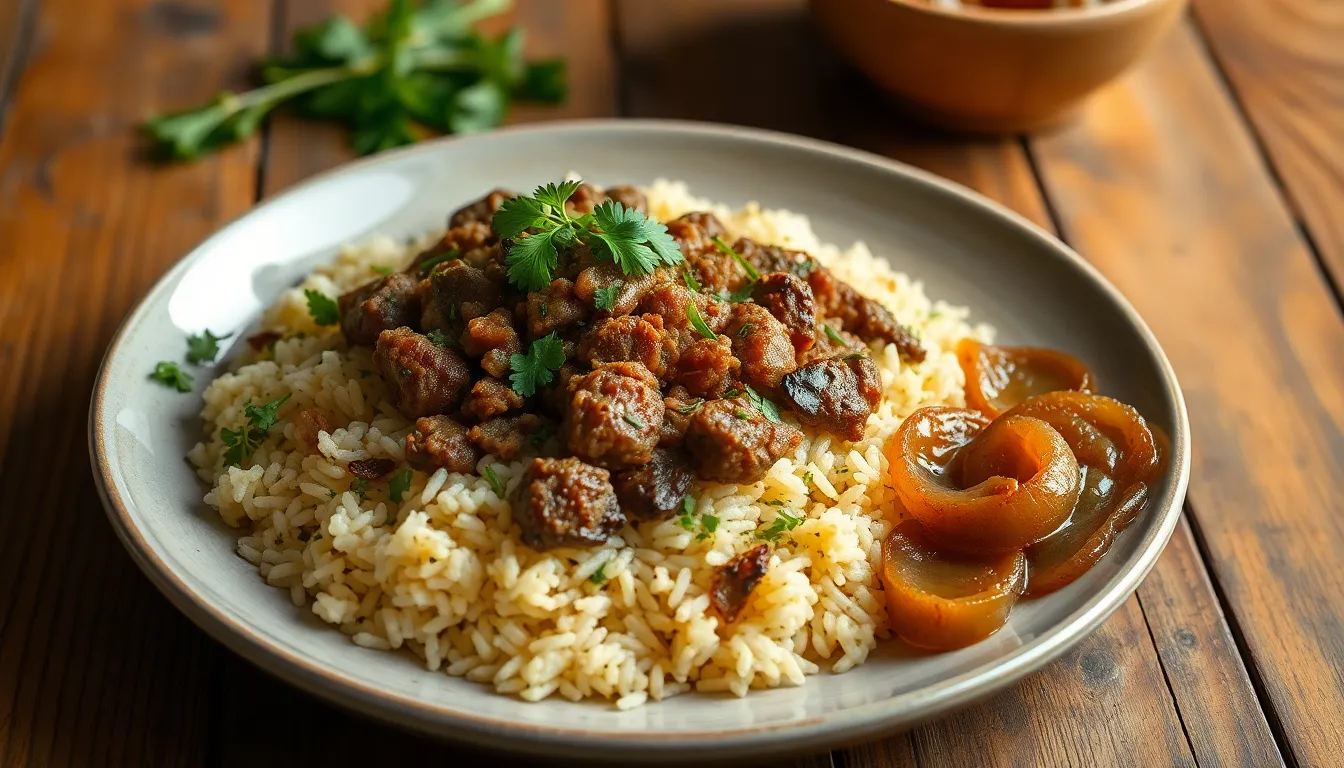
Preparing our Kenyan beef pilau rice ahead of time transforms this elaborate dish into a convenient weeknight meal or stress-free entertaining option. We can break down the cooking process into manageable steps that actually enhance the final flavors.
Prepare the Pilau Masala Spice Blend
We recommend making our pilau masala spice blend weeks in advance. Toast whole spices including cumin seeds, black peppercorns, cinnamon sticks, cardamom pods, and cloves until fragrant. Grind these aromatic spices into a fine powder and store in an airtight container for months. This homemade blend delivers superior flavor compared to store-bought versions and saves precious time during actual cooking.
Pre-Cook the Beef
Beef preparation offers our biggest time-saving opportunity. We can wash and cube the beef then cook it with sliced onions, garlic, ginger, bay leaves, and salt until tender. This process typically takes about one hour but can be completed 2-3 days ahead. Store the cooked beef chunks and rich broth separately in the refrigerator. The flavors actually deepen during storage, creating an even more delicious final dish.
Caramelize Onions in Advance
Properly caramelized onions require patience and attention, making them perfect for advance preparation. We can slowly cook sliced onions in oil over medium heat until golden brown and sweet. These caramelized onions store well in the refrigerator for up to one week and freeze beautifully for longer storage. Simply reheat them gently before adding to our pilau.
Strategic Rice Preparation
While we cannot fully cook the rice ahead of time, we can wash and drain our basmati rice hours before cooking. This allows the grains to dry slightly, resulting in better texture and less stickiness in the final dish. Store the washed rice in a covered bowl at room temperature.
Assembly Day Benefits
When ready to serve, we simply heat our pre-cooked components and combine them with fresh rice and broth. The entire assembly process takes less than 30 minutes, making it ideal for busy schedules. Our pilau actually tastes better when reheated, as the flavors continue to meld and intensify. Store completed pilau in the refrigerator for up to three days, and reheat gently with a splash of broth to restore moisture.
Storage Instructions
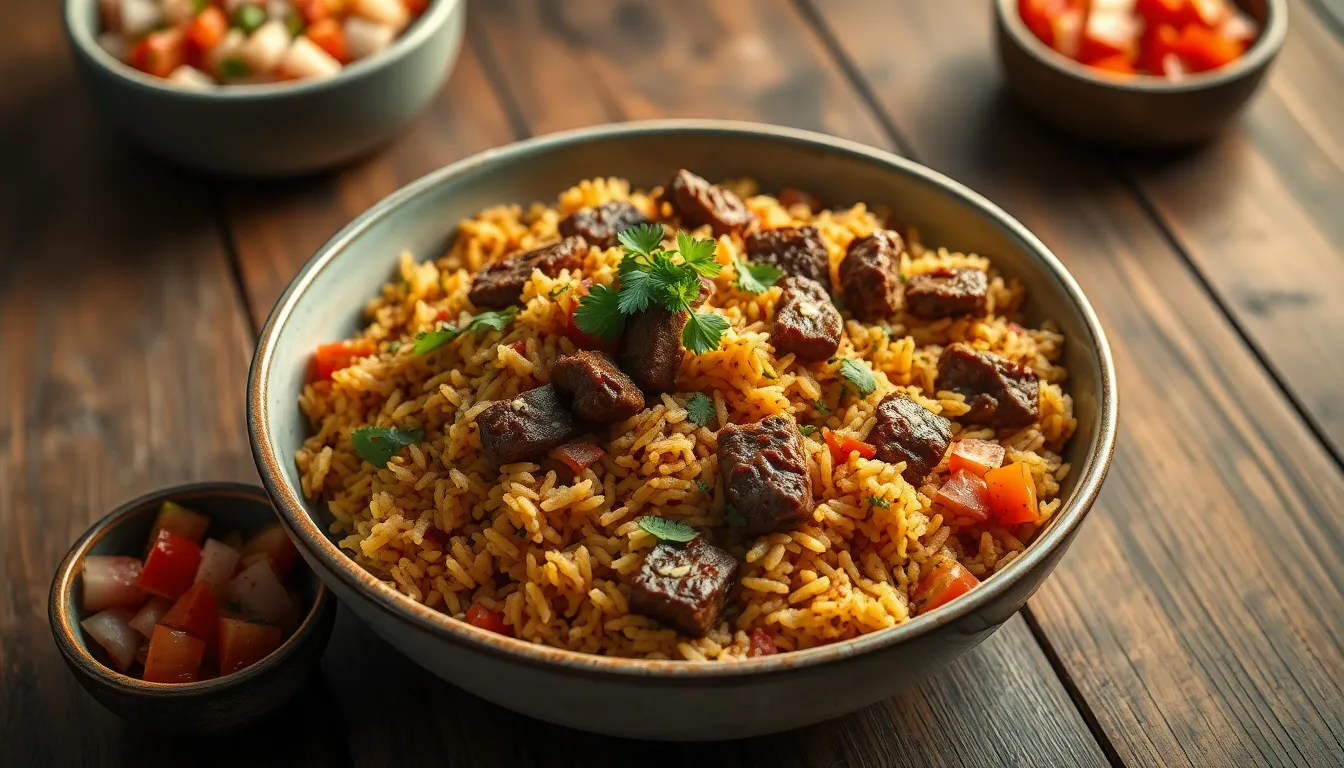
We recommend storing leftover beef pilau in an airtight container in the refrigerator where it will maintain its best quality for up to five days. The dish actually improves in flavor as it sits because the spices continue to meld together.
For longer storage periods, we suggest freezing the cooled pilau in airtight containers or freezer bags. Flatten the freezer bags to help with even freezing and quicker defrosting. Properly stored beef pilau can remain frozen safely for up to two months without losing its authentic taste.
| Storage Method | Duration | Best Practices |
|---|---|---|
| Refrigerator | Up to 5 days | Store in airtight container |
| Freezer | Up to 2 months | Use freezer bags flattened for easy defrosting |
We always let the pilau cool completely before transferring it to storage containers. This prevents condensation from forming inside the container which could affect the rice texture. When reheating refrigerated pilau, we add a splash of water or broth to restore moisture and heat it thoroughly until steaming hot.
If you plan to serve the pilau with fresh kachumbari, we recommend storing the salad separately to maintain its crisp texture and fresh flavor. The tomato and onion salad should be prepared fresh each time for the best taste experience.
For frozen pilau, we thaw it overnight in the refrigerator before reheating. This gradual thawing process helps preserve the rice texture and prevents the beef from becoming tough. When reheating, we cover the dish to trap steam and ensure even heating throughout.
Variations and Substitutions
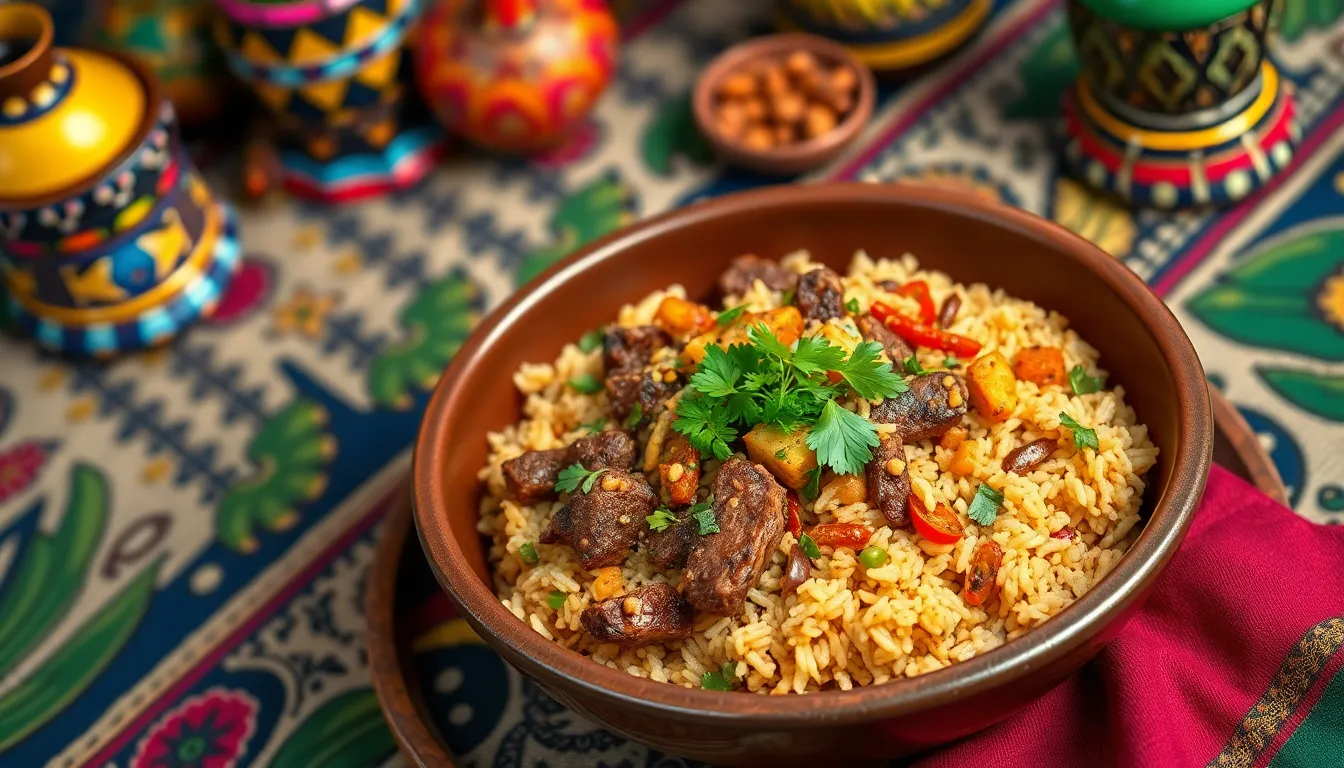
This beloved Kenyan dish offers remarkable flexibility for different dietary preferences and ingredient availability. We can easily adapt our beef pilau recipe to accommodate various tastes and cooking styles while maintaining its authentic character.
Protein Alternatives
Our beef pilau transforms beautifully when we substitute different proteins. Chicken pilau works exceptionally well using bone-in chicken pieces or boneless thighs cut into chunks. The cooking time reduces to approximately 25-30 minutes for tender results. Goat meat provides a traditional alternative popular in many Kenyan households, though it requires longer cooking time similar to beef.
For vegetarian versions, we recommend using mushrooms as the primary protein substitute. Large portobello or button mushrooms cut into substantial pieces absorb the pilau spices wonderfully. We can also incorporate mixed vegetables like carrots, bell peppers, and green beans for added texture and nutrition.
Rice Variations
While golden basmati rice remains our top choice for authentic flavor and texture, several alternatives work effectively. Regular basmati rice delivers similar results with excellent grain separation and fluffiness. Long-grain white rice serves as an accessible substitute, though we recommend reducing the liquid slightly to prevent stickiness.
Some cooks prefer mixing rice varieties, combining basmati with jasmine rice for enhanced fragrance. We suggest maintaining the same liquid ratios regardless of rice type chosen.
Spice Adjustments
Our pilau masala blend adapts well to personal preferences and spice availability. Star anise adds an extra layer of aromatic complexity when available. We can increase cardamom pods from 4 to 6 for more pronounced floral notes, or add bay leaves during the cooking process for earthy depth.
For milder versions, we reduce the black peppercorns and cloves by half. Heat lovers can incorporate dried red chilies or cayenne pepper to the spice blend for additional warmth.
Additional Ingredients
Diced potatoes create a heartier version of our pilau. We add 2-3 medium potatoes cut into 1-inch cubes during the final cooking stage, allowing them to absorb the rich flavors while maintaining their shape.
Raisins or dried fruits provide subtle sweetness that complements the savory spices. We fold in 1/4 cup of golden raisins during the last 10 minutes of cooking for balanced flavor distribution.
Cooking Method Adaptations
Our stovetop method translates well to other cooking appliances. Pressure cooker preparation reduces total cooking time to 20 minutes under high pressure, perfect for busy schedules. Oven cooking at 350°F allows for hands-off preparation, though we cover the pot tightly with foil and a lid for proper steam retention.
Rice cooker versions work effectively by layering ingredients and using the appropriate liquid ratios for your exact appliance model.
These variations maintain the essential character of authentic Kenyan beef pilau while accommodating different preferences and dietary requirements. Each adaptation preserves the dish’s signature aromatic qualities and festive appeal that make it perfect for celebrations and family gatherings.
Conclusion
We’ve shared everything you need to master this beloved Kenyan dish that brings families together around the dinner table. With our detailed recipe and expert tips you’ll create restaurant-quality beef pilau that showcases the authentic flavors of East African cuisine.
The beauty of this recipe lies in its flexibility – whether you’re cooking for weeknight dinners or special celebrations the make-ahead options and storage tips ensure you can enjoy perfect pilau whenever the craving strikes. The aromatic spices and tender beef create a memorable meal that gets even better with time.
Now it’s your turn to bring the rich culinary traditions of Kenya into your kitchen. Gather your spices fire up the stove and prepare to impress your family and friends with this fragrant flavorful masterpiece that’s sure to become a household favorite.
Frequently Asked Questions
What makes Kenyan beef pilau different from other rice dishes?
Kenyan beef pilau is distinguished by its unique blend of whole spices including cardamom, cinnamon, cloves, and cumin, which are toasted and ground fresh to create pilau masala. This spice blend, combined with coastal Swahili influences, gives the dish its signature golden color and aromatic flavor that sets it apart from regular rice dishes.
What type of beef works best for pilau?
Beef chuck roast or stewing beef cuts work best for pilau because they become tender when slow-cooked and absorb the spice flavors well. Cut the beef into uniform cubes for even cooking. These tougher cuts break down beautifully during the cooking process, creating succulent, flavorful meat.
Can I make pilau masala spice blend ahead of time?
Yes, you can prepare pilau masala in advance by toasting and grinding whole spices like cardamom, cinnamon, cloves, and cumin. Store the fresh spice blend in an airtight container for up to one month. Making it ahead saves time and ensures you have this essential component ready for cooking.
What rice is best for Kenyan beef pilau?
Basmati rice is the preferred choice for authentic Kenyan beef pilau due to its long grains, aromatic quality, and ability to absorb flavors without becoming mushy. Wash the rice thoroughly before cooking and let it drain for better texture. Long-grain white rice can be substituted if basmati isn’t available.
How long can I store leftover beef pilau?
Leftover beef pilau can be stored in the refrigerator for up to 5 days in an airtight container. The flavors actually improve over time. For longer storage, freeze the pilau for up to 2 months. Always cool completely before storing and add a splash of water when reheating to restore moisture.
What should I serve with beef pilau?
Beef pilau is traditionally served with fresh kachumbari, a tomato and onion salad that provides a refreshing contrast to the rich, spiced rice. You can also serve it with meat stews, vegetable dishes, or garnish with fresh cilantro for a complete East African dining experience.
Can I make beef pilau in a pressure cooker?
Yes, you can adapt this recipe for a pressure cooker to reduce cooking time. Follow the same steps for preparing ingredients, then pressure cook the beef and spices before adding rice and liquid. Adjust cooking times according to your pressure cooker’s instructions while maintaining the same ingredient ratios.
What vegetarian alternatives work for this recipe?
For vegetarian versions, substitute beef with mushrooms, potatoes, or mixed vegetables while keeping the same spice blend and cooking method. You can also add protein-rich ingredients like lentils or chickpeas. The pilau masala spice blend remains the key to maintaining the authentic flavor profile.

